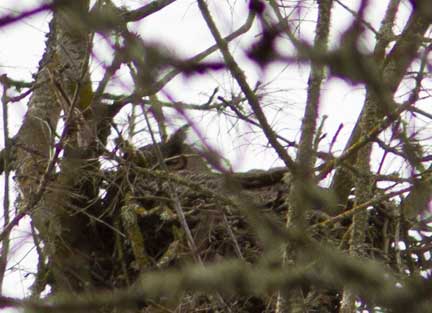 |
Previous Issues |
| Cedar Mill Community Website |
|
Search the Cedar Mill News: |
About The Cedar Mill News |
|
|||||||
| Volume 9, Issue 3 | March 2012 |
||||||
Great Amber Eyes
|
 |
| Great horned owl on nest at Fernhill Wetland, February 13, 2012. Photo © 2012 by Jeff Young. |
My own personal experience with owls is limited, but when I see one I am truly awed. These are magnificently camouflaged creatures. This month's photo is from Fernhill Wetlands (just south of Forest Grove), where we were incredibly fortunate to see this bird peeking over the nest. According to reputable sources, these birds mate for life and start producing offspring when they are about two years old. Both male and female share the duty of sitting on the eggs. There are typically two eggs, which take around 30 days to hatch, and then the baby owls take more time to develop feathers and leave the nest (technical term is fledging). So we look forward to watching this family grow over time. We did not see the other bird on this visit, but hope to later on. Given their camouflage, this will require careful scanning of trees and another dose of incredible luck.
I have heard Great Horned Owls in my back yard in Cedar Mill at night, so I know they nest in this area. Their "hoo hoo hoo hoo"—and maybe even one more note at times—is loud and distinct. Once at dusk I saw one land in my back yard tree for a few moments. That was a real treat and the only time I have seen one in the 13 years I have lived in my home. I hear them a lot in January and February, and then when they start to nest they don't call.
My brother had an encounter with a Great Horned Owl as he was running in Forest Park with his small terrier dog. The owl apparently thought the dog would be tasty, and made a swoop at it. They will eat whatever is available including small dogs and cats. Mostly though, they eat rodents..
What mostly amazes me are their huge eyes, which can bring in lots of light to see in dim conditions. Birds have so many adaptations to specific habitats. Some of them have beaks for cracking open nuts, some drill holes in my trees for sap and insects, and owls have huge eyes to see at night. It reminds me of our human signature strengths. We don't all have to be alike, and being different and unique may allow us to thrive together.
I'm also fascinated by the variations in responses to owls in history. While these creatures are in fact hard to study due to their habits, this has not stopped fertile imaginations from interpretations. In many cultures, owls are revered for wisdom and are symbolic of fertility (such as being the companions of many ancient goddesses of fertility in recovered artwork—due to their association with the night maybe?). Other cultures have found them to be symbolic of rather evil and dark things—harbingers of death and destruction.
Human beings are able to interpret the very same event or animal in markedly diverse and creative ways. To me the owls are intricately adapted to harsh conditions and are such a rare treat that I am transfixed. I think I watched this particular owl for about an hour and the time just melted. What awes you? Get outside and see.
Lauretta Young is a retired chief of psychiatry at Kaiser in Portland and now teaches mind body medicine and leadership at OHSU, she also has a private custom bird touring business where she takes people in search of awe to Cedar Mill and beyond to enjoy birds, bird song and bird behavior—www.portlandbirdwatching.com
See more of her husband's photos posted at www.flickr.com/photos/youngbirders
Published monthly by Pioneer Marketing & Design
Publisher/Editor:Virginia Bruce
503-803-1813
PO Box 91061
Portland, Oregon 97291
© 2011